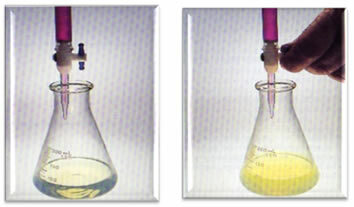In order for a chemical reaction to occur in a mixture of solutions, their solutes must not be the same, as the reaction occurs between them.
In laboratories and chemical industries, most mixtures occur from the occurrence of reactions and, therefore, it is essential to know the stoichiometry of these reactions. This means knowing how to equate the reactions and knowing the proportion in number of moles of the reactants and products, which is given by the coefficients of the balanced equation.
If we know these details, we will be able to determine whether the final solution is neutral, acidic or basic, as well as being able to determine the concentration in mol/L of the product.
To understand how this happens, see an example of a reaction between an acid and a base:
• Mix between 30 mL of sodium hydroxide (NaOH) at 0.7 mol/L and 70 mL of hydrochloric acid (HCl) at 0.3 mol/L.
The reaction that takes place is as follows:
1 NaOH + 1 HCl → 1 NaCl +1 H2O
Note that the reaction ratio is 1:1. Let's see if the mixture is also in this proportion and determine if it is a neutral, acidic or basic mixture. For this it is necessary to find the mol (n) numbers of the reagents:
noNaOH = MNaOH. VNaOH
noNaOH = 0.7 mol/L. 0.03 L
noNaOH =0.021 mol
noHCl = MHCl. VHCl
noHCl = 0.3 mol/L. 0.07 L
noHCl =0.021 mol
So we have:
1 NaOH + 1 HCl → 1 NaCl +1 H2O
Ratio: 1 mol 1 mol 1 mol
Number of mol: 0.021 mol 0.021 mol 0.021 mol
This means that the reaction conforms to the stoichiometric ratio, remaining neutral as there is no excess of acid or base.
The concentration in mol/L (M) of the formed salt can be found by the formula below, remembering that the volume of the solution is the sum of the volumes of acid and base (30 mL + 70 mL = 100 mL = 0.1L):
M = no
V
M = 0.021mol
0.1L
M = 0.21 mol/L
However, if we were to mix a larger amount of NaOH with the same amount of HCl, we would see that the number of moles of NaOH would not obey the stoichiometric ratio, remaining in excess. Thus, we would know that the final solution would present a basic character.
This concept is widely used in a technique called titration, in which the concentration of an unknown solution is determined by its reaction (with the help of an indicator) with a solution of known concentration.

By Jennifer Fogaça
Graduated in Chemistry
Source: Brazil School - https://brasilescola.uol.com.br/quimica/mistura-solucoes-com-ocorrencia-reacoes-quimicas.htm
